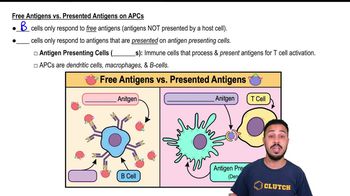How would each of the following prevent infection?
a. antibodies against Neisseria gonorrhoeae fimbriae
b. antibodies against host cell mannose
 Tortora 14th Edition
Tortora 14th Edition Ch. 17 - Adaptive Immunity: Specific Defenses of the Host
Ch. 17 - Adaptive Immunity: Specific Defenses of the Host Problem 17.8a
Problem 17.8a Verified step by step guidance
Verified step by step guidance



How would each of the following prevent infection?
a. antibodies against Neisseria gonorrhoeae fimbriae
b. antibodies against host cell mannose
Match the following choices to the statements in questions 5–7:
a. IgA
b. IgD
c. IgE
d. IgG
e. IgM
Antibodies that are bound to mast cells and involved in allergic reactions.
Explain why a person who recovers from a disease can attend others with the disease without fear of contracting it.
A kidney-transplant patient experienced a cytotoxic rejection of the new kidney. Place the following in order for that rejection: (1) apoptosis occurs; (2) CD8⁺ T cell becomes CTL; (3) granzymes released; (4) MHC class I activates CD8⁺ T cell; (5) perforin released.
a. 1, 2, 3, 4, 5
b. 5, 4, 3, 2, 1
c. 4, 2, 5, 3, 1
d. 3, 4, 5, 1, 2
e. 2, 3, 4, 1, 5
NAME IT A purified protein from Mycobacterium tuberculosis is injected into a person’s skin. A hardened, red area develops around the injection site within 3 days.
Use the following choices to answer questions 1 and 2:
a. hemolysis
b. hemagglutination
c. hemagglutination inhibition
d. no hemolysis
e. precipitin ring forms
Patient’s serum, influenza virus, sheep red blood cells, and anti-sheep red blood cells are mixed in a tube. What happens if the patient has antibodies against influenza?